Include a Topper!
-
Happy Birthday Banner
$9.00 -
Gingerbread Cake Topper
$15.00
Add Ons
Your cart is currently empty!
Since 1949 celebrating 75 years. Order online or call us at 1 800 GAMBINO (426-2466)
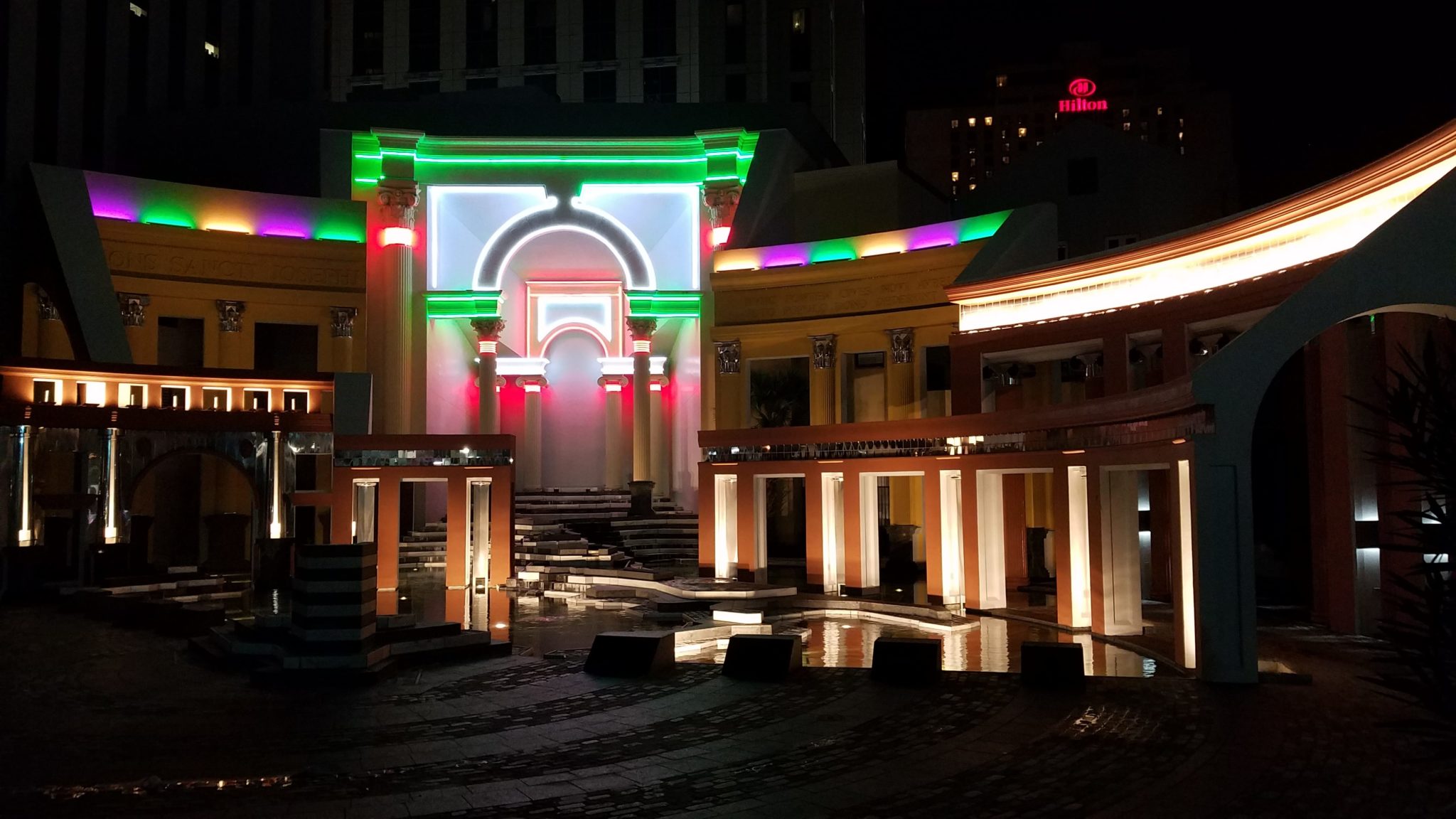
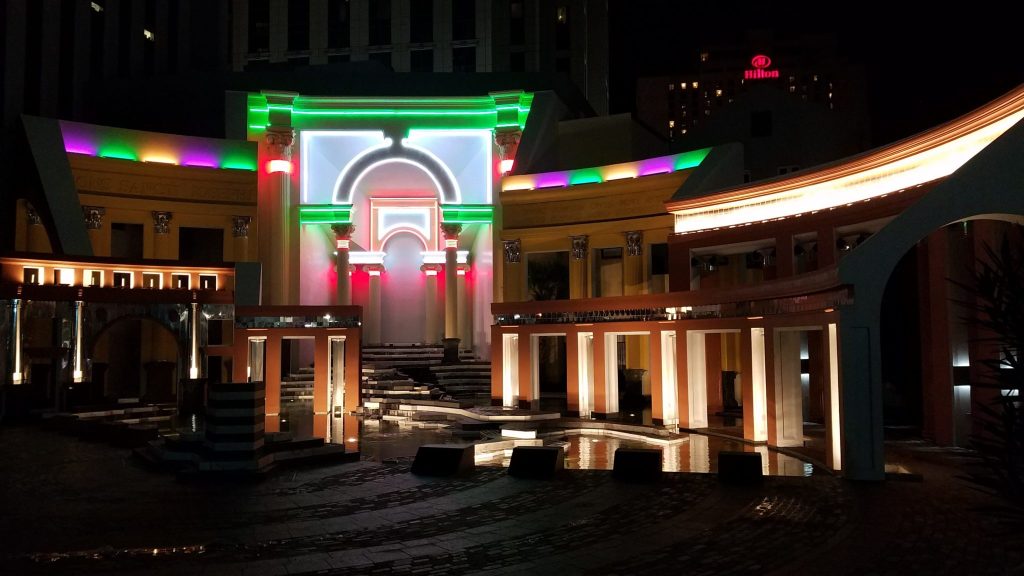
As summer approaches, maybe you’re daydreaming about the Italian vacation you’ve always wanted: the vibrant culture, the people, and the charming piazzas to sit in as you eat your Italian food and sip on your Italian wine.
But guess what? If it’s an Italian piazza you’re after, there’s no need to fly across an ocean. In fact, you don’t even have to leave downtown! Just a few steps from Poydras Street, but unknown to most New Orleanians, Piazza d’Italia is a hidden treasure with an interesting past.
In the approximately 45 years since the piazza was built, some have mocked it as a gaudy mess fit for Disney World while others have admired it as a postmodern masterpiece.
But most New Orleanians don’t even know it exists.
The partially hidden space is painted clay, mustard, light blue, silver, and beige. It features pools, fountains, a massive clock tower, columns sequenced into colonnades, and even a peninsula in the shape of Italy with steps that lead to a Roman temple.
Expressive, clay-colored masks shoot water from their mouths, making for one of several great photo-ops at Piazza d’Italia. But this could-be-landmark was never meant to simply be a photo-op. It was designed as a space in which people could gather, converse, eat, and laugh.
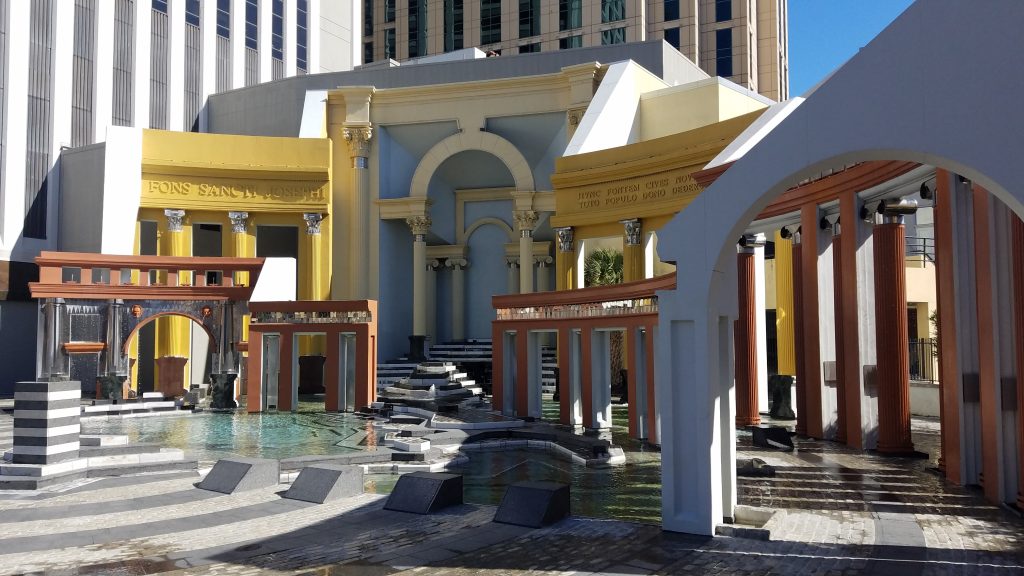
Piazza d’Italia has yet to realize this mission, but it’s still a hidden gem worth visiting. If you’ve never been, this article can help you find it. But even if you already know where the mysterious piece of art is located, you probably don’t know its unique history.
In a June 1973 edition of local newspaper The States-Item, there appeared an article titled, Saving the Downtown Area: New Orleans Showing Other Cities How. The piece outlined how suburban sprawl and “white flight” were causing America’s downtowns to become “virtual wastelands of decaying buildings, faltering businesses and a few high-rise offices in which workers flock from the suburbs every morning and gratefully leave each evening.”
According to the author, however, New Orleans avoided this fate thanks to its French Quarter-fueled tourism. Rather than decaying, downtown New Orleans could be perceived as thriving. The evidence, he wrote, was in a variety of new landmarks recently built, or at least slated to be. Among those landmarks was the Superdome, the Riverwalk Mall, Spanish Plaza, One Shell Square, Mahalia Jackson Theater, Louis Armstrong Park and, of course, our Piazza d’Italia, a monument to the important contributions of New Orleans’ Italian-American community.
The piazza was commissioned by the city’s Italian leadership who bemoaned that New Orleans’ Sicilian culture wasn’t being celebrated at the same level as its French, Spanish, African, and American Indian heritage. Muffulettas, Angelo Brocato’s, “Little Palermo,” the music of Louis Prima, and (if we may be so bold) Gambino’s Bakery — the list of Italian contributions to New Orleans culture could fill books.
Fortunately, the city’s progressive mayor, Moon Landrieu was on board for just about any development that could help revitalize downtown. He agreed the time was right for a monument to New Orleans’ Italian-American heritage.
There was a competition to determine who would design the monument, and a local firm, August Perez and Associates, won with a plan that focused on redeveloping the warehouses already around the square. It was decided, however, that this idea would be merged with the second place design by the nationally renowned architect, Charles Moore. The two plans were seen as complementary, as Moore’s submission focused on the interior of the space rather than the surrounding buildings.
Moore was Dean of the Yale School of Architecture at the time his design for the Piazza d’Italia was accepted, and his personality was renowned as “outgoing, absorptive and engaging.”
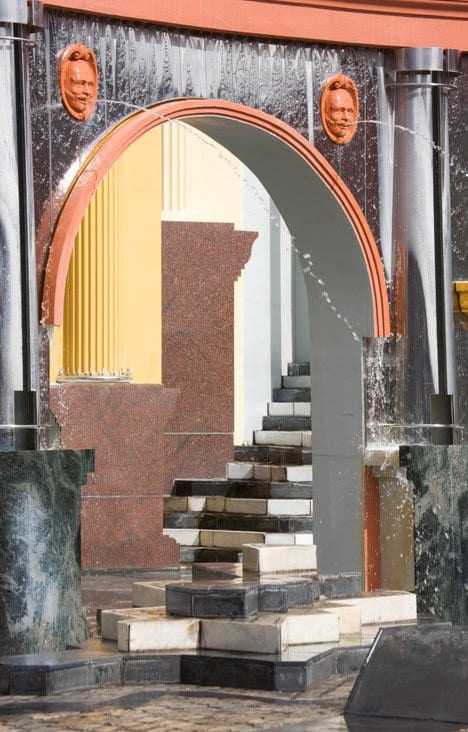
His work could also be described that way with conspicuous design features, loud color combinations, stylistic collisions, esoteric historical designs, and non-traditional materials. His most famous piece is the village of redwood-clad buildings along the rocky, California coast known as Sea Range.
Wild interiors were a common theme in Moore’s work. The inside of many of the Sea Ranch condominiums were decorated with bright supergraphics. In another example, his own mid-1960s New Haven residence was featured in Playboy because of memorable elements of its interior. A freestanding shower in the middle of one room, for instance, nozzled water through a giant sunflower!
Piazza d’Italia flips Moore’s penchant for creative interiors inside out. Here, it’s the exterior that turned heads.
The New York Times’ architecture critic, Paul Goldberger, described the Piazza in March 1979:
“For, while downtown plazas in most cities are mere expanses of empty concrete, this new one has at its centerpiece a set of curving walls containing an array of classical columns and arches and entablatures and friezes, all painted brilliant rust and yellow and orange, and awash with water spouting, flowing, rushing and gurgling around and about and above and below every part of it.
As if that were not enough, the structure is lit up with blue and orange neon ornamentation at night. And the fountains all empty into the central pool with an island of cobblestone and slate and marble that clearly and unquestionably turns out to be the shape of a map of Italy.
The whole thing is a wild, mad vision, as if the Roman Forum were re-erected in Las Vegas. One’s first instinct is to say it is all rather a vulgar slap in the face of classicism — how could Corinthian columns be painted yellow and lit up at night with neon be anything but vulgar?”
“Vulgar” was a common description for the space. Others preferred the words, “ugly” and “inane.”
But every choice Moore made was intentional.
Admiring the way Italians interacted with their piazzas, Moore sought to create a space that would be similarly fun, colorful, vibrant and welcoming for New Orleanians. Interested in Italian history, he made Piazza d’Italia a mash-up of styles that borrowed from periods ranging from Classical to the Baroque.
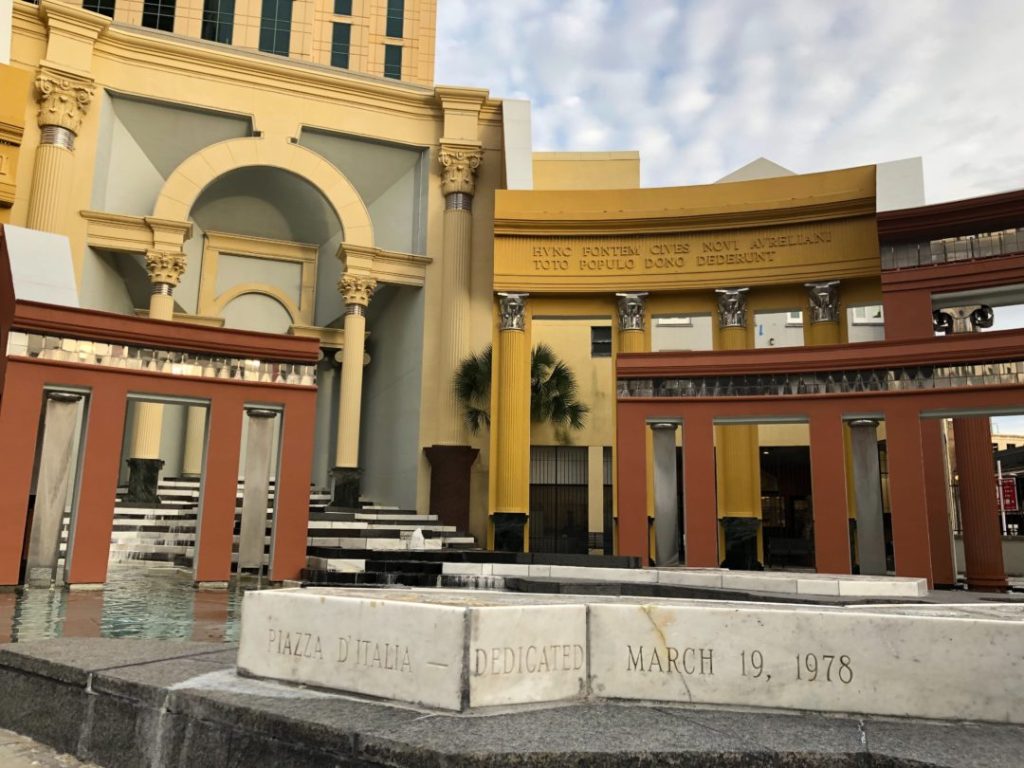
During a time when other Postmodernists used classical elements to poke fun at Modernist orthodoxy, Moore insisted his creation was a sincere and joyful tribute.
In fact, Goldberger went on to clarify his opinion:
“But this place, which may be the most significant new urban plaza any American city has erected in years, is in fact so boundlessly good natured, so utterly full of good will and eagerness to please, that you soon realize that it is not a mockery of classicism at all. It is a laughing, almost hysterically joyous embrace of the classical tradition.”
“Great Architecture tends to inspire admiration, reverence, humility, awe, and other such solemn emotions,” reads a segment on the American Italian Cultural Center’s website. “But rarely does it fill its beholder with feelings of happiness, joy, warmth, and love. The Piazza d’Italia is one of those exceptions.”
Back in 1973, those who believed New Orleans’ downtown was on its way to a renaissance couldn’t possibly have envisioned the oil bust that would arrive at the end of the decade. The result was an intense economic downturn with investment flowing out of the city.
The vision of redeveloped warehouses surrounding this “surprise plaza” never manifested. Instead, a parking lot now borders much of the space.
In the decades that followed the oil bust, the Piazza, itself, fell into disrepair. By 2000, it was frequently mocked as the world’s first “postmodern ruin.”
Fortunately, that’s not where the story of Piazza d’Italia ends.
In 2004, the first renovation of the space was completed. The fountain was rehabilitated and — though unfortunate — the badly deteriorated campanile, or bell tower, on the site’s periphery was removed. Between 2013 and 2018, a second renovation was completed, led by Mayor Mitch Landrieu, son of the mayor who first okayed Piazza d’Italia nearly five decades before.
Today the space is operated by Loews Hotel.
“Our hope,” explained the former Loews Hotel Director of Sales and Marketing, Barry Rodriguez in 2019, “is that Piazza d’Italia will become the urban park that has been envisioned for years.”
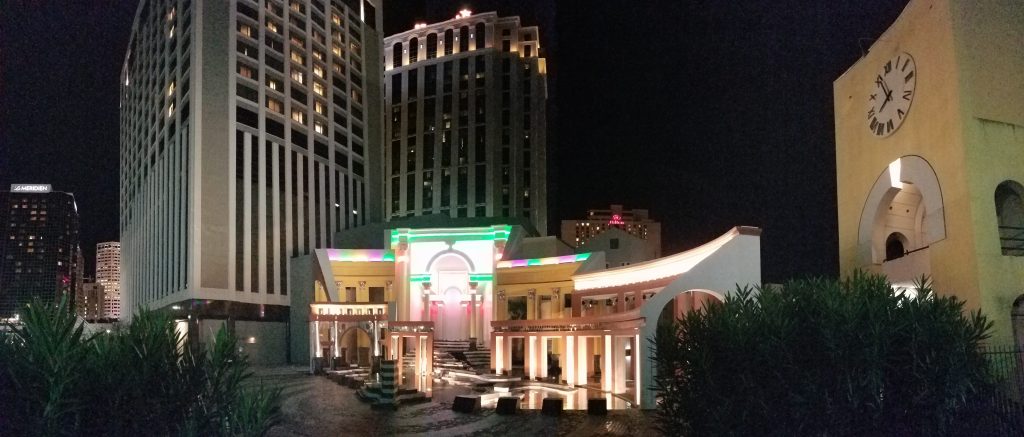
That vision still has a long way to go before it’s realized, but in recent years the piazza has been used for major events such as Luna Fête, as well as operatic and other musical performances.
For residents who have stumbled upon Piazza d’Italia, it’s common to hear them describe it as a surprise — kind of confusing, kind of gaudy, and don’t say it too loud, but kind of beautiful, too.
It’s undoubtedly unique.
And it’s ours.
The inscription on the temple reads, “FONS SANCTI JOSEPHI. HVNC FONTEM CIVES NOVI AVRELIANI TOTO POPULO DONO DEDERUNT.” That translates to “The Fountain of St. Joseph: The citizens of New Orleans have given this to all the people as a gift.”
So enjoy it. You’ll find it surrounded by Poydras Street and the Loews Hotel downriver, the American Italian Cultural Center and St. Peters Street on the river-side, Lafayette Street upriver, and a parking lot and Tchoupitoulas Street on the lake-side.
Take time to walk along Piazza d’Italia’s curves, between its fountains, and through its colonnades.
And, maybe one day, a vision from more than 40 years in the making will be realized: we won’t just walk through Piazza d’Italia for a photo. We’ll stay for a glass of wine and listen to live music on her steps. We won’t see a parking lot. We’ll be surrounded by the colorful, impressive buildings of downtown New Orleans.
And maybe one day we’ll learn to appreciate one of our city’s truly hidden gems.